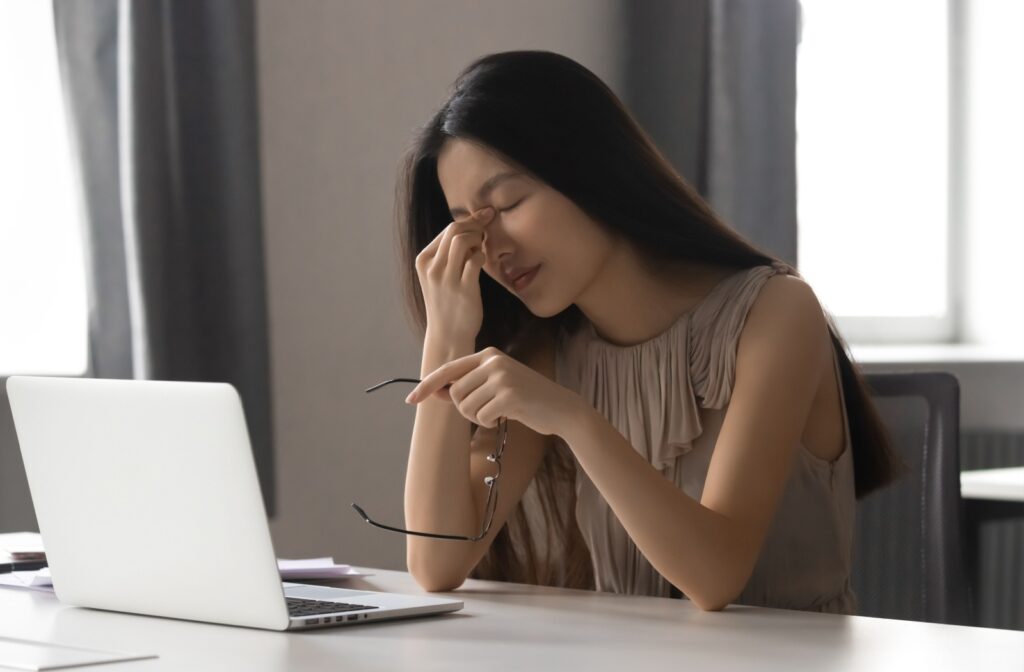Eye strain has become a common concern for many as we live and work closely with screens. Spending prolonged hours in front of digital devices can increase your risk of eye-related discomfort and fatigue. An eye condition, such as dry eye or an untreated vision problem, can also cause eye strain or worsen eye strain symptoms from excessive screen time.
But how long can eye strain last? There is no definitive answer for how long eye strain can last, as it depends on the cause. However, if you stop using a screen, eye strain can go away within an hour or may take longer if you have accompanying eye strain symptoms.
What Is Eye Strain?
Eye strain is when you experience a range of symptoms after extended use of the eyes. It’s not a disease or a disorder but rather a signal from your eyes that they’re overworked.
Several factors contribute to the onset of eye strain, including:
- Staring at digital screens, such as a computer, smartphone, or tablet, for prolonged periods without breaks is a primary contributor to digital eye strain or computer vision syndrome.
- Holding digital devices too close or far from the eyes.
- Intense focusing on an activity, such as reading a book or driving for a long time.
- Excessive brightness or insufficient lighting can lead to eye discomfort and strain.
- Poor ergonomics while sitting or using devices can put undue stress on the eyes and surrounding muscles.
- Underlying vision problems, such as dry eye, can lead to eye strain.
- Uncorrected refractive errors like myopia, farsightedness, astigmatism, and presbyopia.
- Not blinking enough to provide a smooth and hydrated eye surface.
Symptoms of eye strain can be numerous and may include:
- Dryness in the eyes
- Sore or tired eyes
- Red eyes
- Irritated eyes
- Blurry vision
- Headaches
- Pain or strain in the neck, back, or shoulders
How Long Can Eye Strain Last?
There is no one answer to how long eye strain can last, as it will depend on the severity and cause of the eye strain. Generally, eye strain does not last very long. If your eye strain results from prolonged screen time and you stop interacting with the screen, your eye strain should go away within the hour.
However, with eye strain, if you have accompanying symptoms such as dry eye, neck or shoulder pain, and headaches, eye strain can take longer to resolve. If eye strain persists for longer, visit your eye doctor for an eye exam to determine the underlying cause.
Prevent & Manage Eye Strain
Mitigating eye strain is not just about treating the symptoms. It is also adopting a preventive approach. Here are key strategies for preventing and managing eye strain.
Prevention Strategies
Adopting several simple habits can reduce the risk of developing eye strain:
- Take breaks: Every 20 minutes, look at something 20 feet away for 20 seconds.
- Proper lighting: Lighting, such as too dim or bright, can cause eye strain. Adjust the lighting so that it’s adequate to reduce glare and squinting.
- Ergonomic setup: Position your screen at arm’s length and at or below eye level to decrease the need for excessive eye movement. Also, consider adjusting the height of your chair or desk to encourage proper posture.
Management Strategies
When eye strain sets in, use these strategies to provide relief:
- Blinking more frequently: Blinking moistens the eyes, reducing dryness and the associated eye strain.
- Artificial eye drops: Preservative-free artificial eye drops or tears can provide lubrication and temporary relief. Consult your eye doctor on which eye drops to use.
- Computer glasses: Blue-light-blocking glasses can filter blue light emitted from digital screens. Your eye doctor can recommend blue light-blocking glasses for your needs.
The Importance of Regular Eye Exams
If eye strain is more frequent, such as more than 2 or 3 times per week, or symptoms affect your quality of life, visit your optometrist. One of the most crucial steps in managing and preventing eye strain is scheduling regular comprehensive eye exams. Eye exams offer the opportunity to discuss concerns you have regarding eye strain.
During an eye exam, your eye doctor can detect changes in your vision, an uncorrected eye prescription, and any underlying eye conditions. Based on the findings, they can prescribe necessary corrections and offer tailored advice for your symptoms and vision needs.
Healthy Eyes & Vision
While eye strain is becoming more pervasive in our modern lives, there are ways to prevent and manage your symptoms. With the right knowledge of what causes eye strain and a few lifestyle adjustments, you can tackle eye strain for healthy, clear, and comfortable vision.
If you experience persistent eye strain or notice vision changes, book an appointment with Broadway Eyecare to determine the cause and receive personalized treatment.









